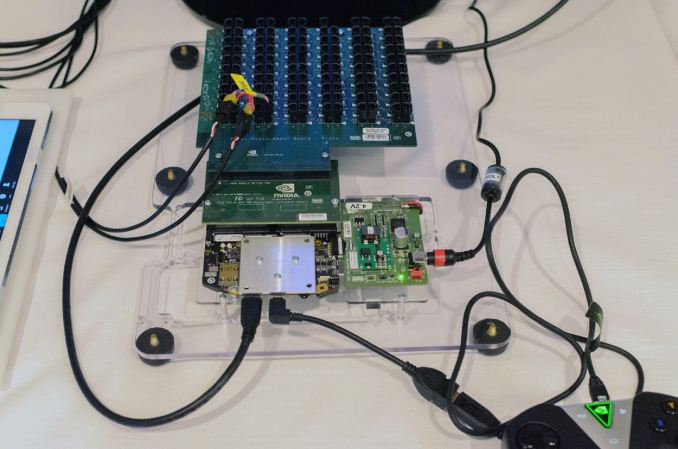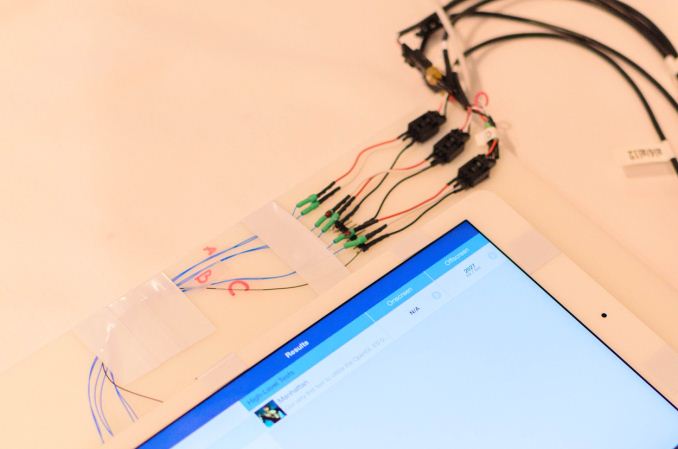NVIDIA Tegra X1 Preview & Architecture Analysis
by Joshua Ho & Ryan Smith on January 5, 2015 1:00 AM EST- Posted in
- SoCs
- Arm
- Project Denver
- Mobile
- 20nm
- GPUs
- Tablets
- NVIDIA
- Cortex A57
- Tegra X1
GPU Performance Benchmarks
As part of today’s announcement of the Tegra X1, NVIDIA also gave us a short opportunity to benchmark the X1 reference platform under controlled circumstances. In this case NVIDIA had several reference platforms plugged in and running, pre-loaded with various benchmark applications. The reference platforms themselves had a simple heatspreader mounted on them, intended to replicate the ~5W heat dissipation capabilities of a tablet.
The purpose of this demonstration was two-fold. First to showcase that X1 was up and running and capable of NVIDIA’s promised features. The second reason was to showcase the strong GPU performance of the platform. Meanwhile NVIDIA also had an iPad Air 2 on hand for power testing, running Apple’s latest and greatest SoC, the A8X. NVIDIA has made it clear that they consider Apple the SoC manufacturer to beat right now, as A8X’s PowerVR GX6850 GPU is the fastest among the currently shipping SoCs.
It goes without saying that the results should be taken with an appropriate grain of salt until we can get Tegra X1 back to our labs. However we have seen all of the testing first-hand and as best as we can tell NVIDIA’s tests were sincere.
| NVIDIA Tegra X1 Controlled Benchmarks | |||||
| Benchmark | A8X (AT) | K1 (AT) | X1 (NV) | ||
| BaseMark X 1.1 Dunes (Offscreen) | 40.2fps | 36.3fps | 56.9fps | ||
| 3DMark 1.2 Unlimited (Graphics Score) | 31781 | 36688 | 58448 | ||
| GFXBench 3.0 Manhattan 1080p (Offscreen) | 32.6fps | 31.7fps | 63.6fps | ||
For benchmarking NVIDIA had BaseMark X 1.1, 3DMark Unlimited 1.2 and GFXBench 3.0 up and running. Our X1 numbers come from the benchmarks we ran as part of NVIDIA’s controlled test, meanwhile the A8X and K1 numbers come from our Mobile Bench.
NVIDIA’s stated goal with X1 is to (roughly) double K1’s GPU performance, and while these controlled benchmarks for the most part don’t make it quite that far, X1 is still a significant improvement over K1. NVIDIA does meet their goal under Manhattan, where performance is almost exactly doubled, meanwhile 3DMark and BaseMark X increased by 59% and 56% respectively.
Finally, for power testing NVIDIA had an X1 reference platform and an iPad Air 2 rigged to measure the power consumption from the devices’ respective GPU power rails. The purpose of this test was to showcase that thanks to X1’s energy optimizations that X1 is capable of delivering the same GPU performance as the A8X GPU while drawing significantly less power; in other words that X1’s GPU is more efficient than A8X’s GX6850. Now to be clear here these are just GPU power measurements and not total platform power measurements, so this won’t account for CPU differences (e.g. A57 versus Enhanced Cyclone) or the power impact of LPDDR4.
Top: Tegra X1 Reference Platform. Bottom: iPad Air 2
For power testing NVIDIA ran Manhattan 1080p (offscreen) with X1’s GPU underclocked to match the performance of the A8X at roughly 33fps. Pictured below are the average power consumption (in watts) for the X1 and A8X respectively.
NVIDIA’s tools show the X1’s GPU averages 1.51W over the run of Manhattan. Meanwhile the A8X’s GPU averages 2.67W, over a watt more for otherwise equal performance. This test is especially notable since both SoCs are manufactured on the same TSMC 20nm SoC process, which means that any performance differences between the two devices are solely a function of energy efficiency.
There are a number of other variables we’ll ultimately need to take into account here, including clockspeeds, relative die area of the GPU, and total platform power consumption. But assuming NVIDIA’s numbers hold up in final devices, X1’s GPU is looking very good out of the gate – at least when tuned for power over performance.














194 Comments
View All Comments
kron123456789 - Monday, January 5, 2015 - link
Not exactly. 8800GTX has much more TMUs and much faster memory.GC2:CS - Monday, January 5, 2015 - link
Not exactly in a phone... Rather in a tablet or a notebook.PC Perv - Monday, January 5, 2015 - link
Perhaps you guys can carry a power bank of known quality to this type of demo and use it instead of whatever the demo unit is hooked up to? I was appalled to see a Nexus 9's dropping battery percentage while it was being charged at a local Microcenter. Granted I do not know what kind of power supply it was hooked up to, but all it was running was a couple of Chrome tabs.Maleficum - Monday, January 5, 2015 - link
I simply cannot trust anything nVidia says. The K1 Denver is such a benchmark cheater.ajangada - Monday, January 5, 2015 - link
Umm... What?chizow - Monday, January 5, 2015 - link
Fun fact: Nvidia was the only GPU/SoC vendor that *DIDN'T* cheat in AnandTech's recent benchmark cheating investigations. ;)http://www.anandtech.com/show/7384/state-of-cheati...
techconc - Monday, January 5, 2015 - link
@chizow: Another fun fact: The article you reference was specifically addressing the state of cheating among Android OEMs. In fact, the article specifically states "With the exception of Apple and Motorola, literally every single OEM we’ve worked with ships (or has shipped) at least one device that runs this silly CPU optimization." Perhaps you're going to fall back on weasel words and claim that neither Motorola nor Apple are GPU/SoC vendors. If that's the case, then you should also note that this kind of cheating is done at the OEM level, not the SoC vendor level.chizow - Monday, January 5, 2015 - link
It was actually a simple oversight, I thought I mentioned Android SoC/GPU vendor but it may be because I saw it in the link instead.Maleficum - Tuesday, January 6, 2015 - link
The link you gave doesn't contain anything related to the Denver core that cheats at the firmware level.Of course, it's called "optimization" by nVidia.
chizow - Tuesday, January 6, 2015 - link
Proof of such cheats would be awesome, otherwise I guess we can just file it under FUD.